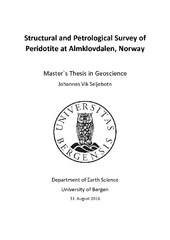Structural and Pertrological Survey of Peridotite at Almklovdalen, Norway
Master thesis
Permanent lenke
https://hdl.handle.net/1956/13141Utgivelsesdato
2016-10-10Metadata
Vis full innførselSamlinger
- Department of Earth Science [1034]
Sammendrag
The Western Gneiss Region (WGR) HP-UHP metamorphic terrain is a part of the Baltic continental crust generated during the Gothian orogeny and re-mobilized during the Sveconorwegian and the Caledonian orogenies. During its geological evolution hundreds of m3 to km3 scale peridotite bodies were emplaced into the crustal gneisses. These peridotites represent subcontinental lithospheric mantle (SCLM) consisting dominantly of chromite- bearing depleted dunites and harzburgites occurring as E-W elongated massifs and lenses throughout the whole WGR. Discrete zones of eclogite, garnet pyroxenite and garnet peridotite occur within some of the peridotites and these zones are suggested to represent zones of Proterozoic refertilization or layered cumulates. The garnet-bearing assemblages and their retrograded equivalents are suggested to be genetically related to both each other and the depleted dunite in which they occur. Garnet-bearing assemblages and their retrograded equivalents provides kinematic indicators which are used to deduce deformation processes that affected the peridotite throughout its geological evolution. Extensive folding of these lithological elements which occur within a restricted field area are analyzed and related to processes of formation. Two competing models of emplacement differs in terms of age, provenance and time and process of emplacement. These models are by this survey tested against new structural and geochemical analytical results. The up-trusting model suggests Baltic provenance and emplacement during the Gothian orogeny. The sinking intrusion model suggests Laurentian provenance and emplacement during the Gothian orogeny. General mapping of the Almklovdalen peridotite and detailed mapping of selected field areas provide new geological maps of the of the entire massif and the selected area.
